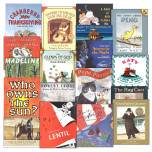We use cookies to make your experience better. To comply with the new e-Privacy directive, we need to ask for your consent to set the cookies. Learn more.
This series provides a wonderful way to nurture your relationship with your children and foster a lifelong adventure of learning. The Five in a Row title comes from reading the same classic children's book five days in a row as a literature-based unit study to cover social studies, character, language arts, math, science and art. Use as a stand-alone program for preschool, or supplement with phonics and math and use it with older children. Literature selections contain positive moral stories that reflect Biblical values. Choose from many possible activities for each day.
The original Five in a Row series was written three decades ago for the previous generation of homeschoolers. Now, the author's children have undertaken the task of modernizing the series and updating the literature lists. All books in the series will eventually be revised; however, at this writing Beyond Five in a Row series is still in the previous edition.
Before Five in a Row has much the same content as the original book, but with three additional stories included. There are also updated illustrations,Animal Classification Cards that help children develop simple classification skills, and StoryDisks and a Storybook Map (an enjoyable way to teach where the story takes place). This book is a collection of discussion and play-based lessons to do for 10-15 minutes 2 or 3 days a week. It doesn't follow the typical 5 day a week schedule. The first of two parts list the 24 stories, along with creative activity suggestions such as examining the stars or using colored tissue paper to make a simple collage. The second part is filled with ideas to build a foundation of readiness – talking and listening skills, coordination skills, activities in the kitchen and other primary skills.
More Before Five in a Row includes 14 new books. It has been specifically written as a preschool curriculum (ages 3-5) and follows the typical format of the Five in a Row books. New to this book, however, is an encouraging Bible lesson before each story written specifically for the parent. Many lessons are built around six early literacy skills: vocabulary, narrative, print awareness, phonological awareness, letter knowledge, and print motivation. The gentle activities are not meant to teach in-depth concepts, but to enhance your child's awareness of the world around them. Centered around play and discussion, the program provides a wide variety of activities involving science, social studies, Bible, language arts, health and much more. An Animal Classification game, StoryDisks and a Storybook Map are included in the back. The activities are a bit more detailed than in Before FIAR.
Completely redesigned and updated with added content, the second edition of Five in a Row still has the same goal of providing elementary students with a quality educational foundation through well written and illustrated books. All you will need to complete the curriculum for 5-and-6-year-olds is a good phonics program and a simple introduction to math. For older children who are reading successfully, it is recommended to supplement with math, spelling, penmanship, and grammar material for a complete curriculum.
Volume 4 and Volume 5 are the newest editions to the series. Volume 4 is designed for older elementary (9 years and up). The activities related to the different subjects in this volume are more involved; therefore, volume 4 books are read for 2 weeks instead of one. This volume prepares students for Level 5 as students transition to reading chapter books. Volume 5 picture books are also read for two weeks and are geared toward students going into the middle school years (ages 10 and up). Volume 5 also includes two chapter books with accompanying lessons (previously published in Beyond Five in a Row Volume 1). The lessons in these volumes are full of interesting and engaging activities for all subject areas. There is enough variety yet substance to keep it interesting for the older students.
The new editions include special teaching tips from the author (including step-by-step guidance for each day of the week), along with an explanation of the philosophy behind the program. There is also a "Teacher's Note" page and activity sheets following each book lesson. The "Teacher's Note" page is handy to record relevant information such as activities done, library resources or videos used, and any field trip opportunities taken. The three or four activity sheets for each book title correlate with some of the activities and really add to the program. These sheets are reproducible for family use only. The books in each program remain the same with a couple of exceptions. They Were Strong and Good was taken out of Volume 2 and The Old Woman Who Named Things was added to Volume 3. Literature packages contain all available books for each volume. Most titles are readily available; however there might be some titles that are out of print. At the back of each manual, Volumes 1-5, you'll find a section called "Finding the Books" which has helpful information on locating out of print titles. Note: the Five in a Row guide is not included in the literature packages.~ Gina





























